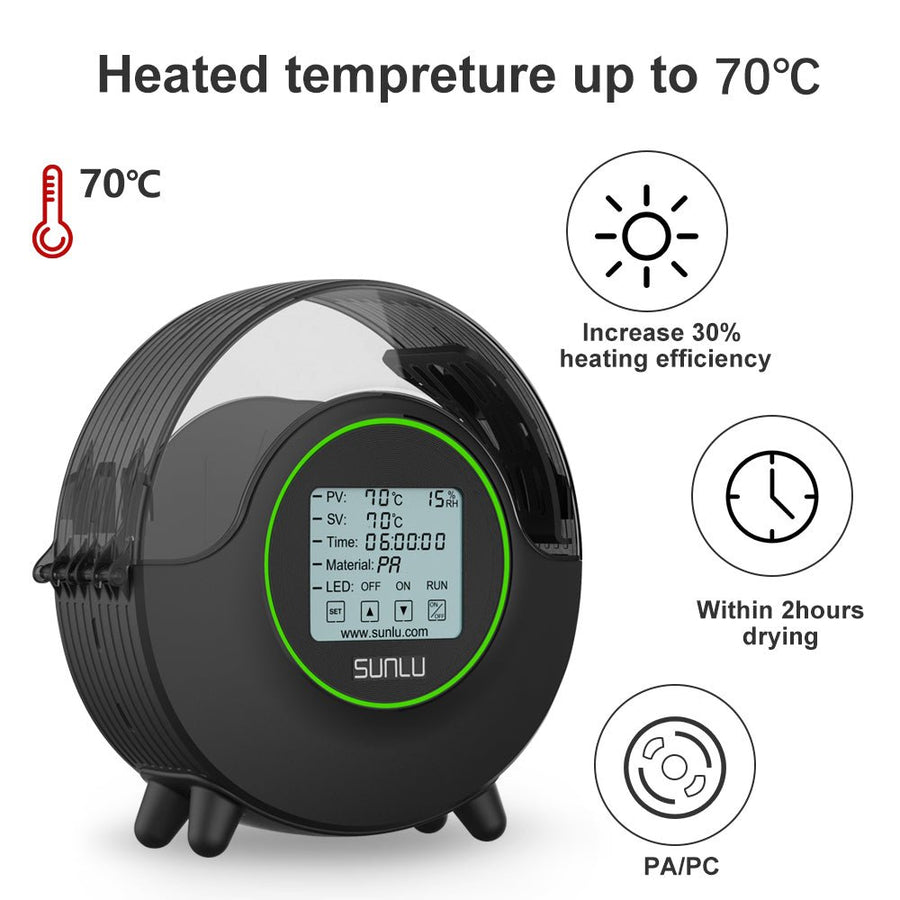What is the filament dryer and its importance in 3D printing
3D printing has burgeoned rapidly in recent years as a transformative manufacturing technology. By harnessing thermoplastics and depositing them in a precise, layer-by-layer fashion, 3D printers are capable of bringing digital models into tangible objects. The quality and properties of the thermoplastic filaments are instrumental to the fidelity(precision) and resolution of the printed parts.
3D printing filaments, which are often polymers, must be heated to a target temperature at which they become sufficiently viscous to be extruded. Filaments that have been exposed to moisture can exhibit worse properties when melted, compromising the quality and consistency of the printed components. Consequently, desiccating 3D printing filaments is paramount to exacting quality control and mitigating issues related to humidity such as bubbles forming. Filament dryers are designed to minimize moisture content and maintain the consistency and stable properties of the filaments to ensure optimal 3D prints.
Filaments that are not properly dried will lead to problems including clogging, uneven extrusion, and geometric distortion. A well-designed filament dryer, especially one equipped with tightly controlled temperature settings and multi-angle enveloping heating, is thus vital to 3D printing. When used properly in accordance with the specific filament type, a filament dryer can get of humidity-related defects and enable the quality of 3D prints. In summary, carefully drying and regulating filaments is essential to unlocking the full potential of 3D printing technology.

What is Filament Dryers?
The quality and dryness of materials play a crucial role in 3D printing. A specialized device known as a 3D printing filament dry box is exclusively designed to facilitate the drying and storage of 3D printing materials. By effectively regulating parameters such as temperature and humidity, this device removes moisture from the materials, guaranteeing their optimal condition for printing.
3D printing filament dryers are equipped with sophisticated sensors and control systems, enabling meticulous management of the drying process, including temperature and humidity within precise ranges. Moreover, some filament dryers also incorporate filtration systems, facilitating the removal of impurities and minuscule particles from the surrounding atmosphere, thereby ensuring a pristine environment.
The utilization of a filament dryer contributes to the dryness of printing materials, thereby enhancing print quality and mitigating the risk of printing failures. In essence, a 3D printing filament dry box stands as an indispensable device, bestowing critical assurance upon the quality and stability of 3D printing materials. By exerting control over material humidity, they engender dependability and favorable success rates throughout the 3D printing process, providing users with a better printing experience and delivering finished products of elevated quality.
The Operational Principle of Filament Dryer
1.Temperature control: The filament dryer is equipped with heating elements that provide stable temperatures. Appropriate temperatures are set based on the material requirements to remove moisture effectively.
2.Humidity control: The filament dryer includes humidity sensors and a humidity regulation system to precisely control the humidity levels inside. By reducing humidity, The filament dryer effectively removes moisture from the materials, which ensures they remain dry.
3.Air circulation: The filament dryer usually has a well-designed air circulation system which helps accelerate moisture evaporation and expulsion to ensure even distribution of air throughout the chamber guaranteeing uniform heating during the drying process.
4.Filtration system: Some high-end filament dryers are equipped with filtration systems to remove impurities and particles from the air. This helps maintain a clean environment, preventing contamination of the materials and enhancing print quality.

Most filament dryers only provide heating and airflow functions. Some filament dryers even require manual shutdown of the heating element. If you forget to turn it off, it will waste a lot of electricity. Different filaments require different drying temperatures. So the temperature range limits the types of 3D printer filaments the dryer can handle.
SUNLU has developed two filament dryers. The Filadryer S2 is their most powerful filament dryer, with a maximum temperature of up to 70°C. This allows the S2 to offer broader compatibility for drying various materials, including PLA, ABS, Nylon, and other filament types. In a compact form factor, it provides an expansive touchscreen interface displaying metrics like temperature, moisture levels, target temperature, timer, and material type. The S2 has built-in heating settings optimized for different 3D printer filaments. You can finish drying your 3D filament in one click.

Benefits of A Filament Dryer
1.Warping and Bubbles Prevention: A filament dryer effectively removes moisture from 3D printing materials by controlling temperature and humidity. Moisture has a significant impact on materials, leading to printing issues such as warping and bubbles.
2.Reduced Clogging and Better Extrusion: By employing a filament dryer, clogging can be minimized and optimal efficiency and smooth extrusion for your 3D printers can be guaranteed.
3.Extending Material Lifespan: Humidity can degrade the performance and lifespan of materials. The filament dryer ensures that the materials remain dry, prolonging their usability and reducing material waste and costs.
4.Better Durability: By ensuring filament dryness, its durability is heightened, reducing the possibility of breakage or cracking throughout the printing process. Consequently, your 3D printing results will exhibit elevated quality and longevity.
Overall, a filament dryer plays a crucial role in maintaining optimal moisture levels in 3D printing materials, ensuring superior print quality, reliability, and cost-efficiency throughout the printing process. We must value the role of the drying box in 3d printing and use it.
